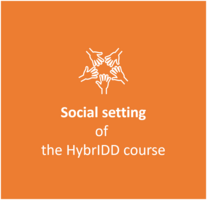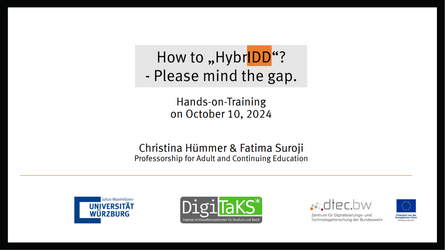Social setting of the HybrIDD course

The social setting includes the group characteristics, the group dynamics, the methods and social forms, and the roles of students and lecturers. We assume that these constitute the HybrIDD course on a social-interactive level.
- By group characteristics, we mean the group size and the respective number of on site and online participants, but also the internationality of and the different media skills within the group.
- We understand group dynamics to mean the relationships within the group and the implicit group norms that can affect learning.
- Methods are understood the how of teaching. They are closely linked to social forms, which include, among other things, lecturer-centred teaching, plenum, individual, partner or group work.
- The roles of the students and lecturer are constituted in social interaction. They can be consciously and actively assumed or assigned.
"In terms of co-creation, the design of [hybrid] learning spaces is understood
as a social endeavor and a shared responsibility between lecturers and learners."
(Hümmer et al., accepted, translated from German)
-
In terms of group characteristics, the number of participants, their respective familiarity and the heterogeneity of the participants appear to have an influence on the implementation of synchronous-hybrid teaching-learning settings: Thus, in a smaller group in which the students already know each other in advance or are given opportunities in the course to become familiar with each other, an open and trusting mode of collaboration can be quickly established. In international groups, on the other hand, the different backgrounds, realities and lives of the students make joint collaboration in a synchronous-hybrid teaching-learning setting challenging, although they are enriching for the learning experience. The respective media skills of the participants can also influence the interaction in the synchronous-hybrid teaching-learning setting. Accordingly, it seems important to address the aspects described as transparently as possible in the group in order to develop a way of dealing with it together. For instance, explicit experimental spaces for trying out digital tools and media technology can be created to develop students' media skills.
-
Numerous methods such as lectures, demonstrations of experiments, portfolio and project work, learning circles and world cafés can be used in synchronous-hybrid teaching-learning settings. These are carried out in a wide variety of social forms, including face-to-face teaching, group and team work and discussions in plenary sessions. Both, methods and social forms can be implemented in such a way that on site participants work exclusively with on site participants and online participants only collaborate with online participants. Or they can take place across locations between all participants, which is, however, more challenging to implement in terms of didactics and methods.
-
The synchronous-hybrid teaching-learning setting is new for many students. Accordingly, they often do not know how they should behave in the setting. The joint negotiation of group norms has proven to be very helpful. This can be done at the beginning of the semester, for example, by developing a code of conduct. In this context, the challenges of the respective participation mode (online and on site) can be discussed together with the students and possible solutions can be defined. For example, it can be discussed that students should actively participate in the learning process when participating online because they should not just be passive listeners as this can have a negative impact on the learning experience for all participants. Active participation requires, for example, that the online participants are visible at all times and can be heard if necessary. Or it can be discussed how communication barriers can be removed. For example, the group can agree to pay attention together to participants making an effort to contribute. This also means drawing the lecturers' and students' attention to a virtual “raise your hands” or inputs written in the chat. The code of conduct must be reflected on again and again throughout the semester and, if necessary, renegotiated and practiced.
-
To enable equal participation experiences, lecturers take on a mediating role between the on site and online participants. At the same time, in the synchronous-hybrid teaching-learning setting, a change in the lecturers' understanding of their role towards that of learning facilitator can be identified. Lecturers are no longer purely concerned with imparting knowledge, but with enabling a co-creative design of the hybrid setting and processing of learning content. Accordingly, students increasingly take on the role of co-creative actors in the synchronous-hybrid teaching-learning setting: they set up the media technology, rearrange the furniture and media in the seminar room according to the didactic-methodical objectives and become active as co-moderators, for example in group work or in plenary discussions.
From students for students: Tips for successful participation in synchronous-hybrid teaching-learning settings
We asked students of the JMU what recommendations they would give to other students so that participation in synchronous-hybrid teaching-learning settings can be successful. This is what they answered:
To prepare students for co-creative collaboration in the HybrIDD course, we have developed a training.
This is aimed at (international) JMU students who attend synchronous-hybrid teaching-learning settings at the Professorship of Adult and Continuing Education and is always held at the beginning of the semester across all courses. The training is scheduled for 90 minutes and is conducted in the seminar room, whereby students can participate online if they have a quiet learning environment and appropriate media technology at home.
To see how the training is structured, click here.
If you want to take a look at the PowerPoint Presentation we developed for the training, click here.
We would be delighted if the materials developed were to be used further or used as an impetus for developing your own materials.
Breitschwerdt, L.; Hümmer, C. & Egetenmeyer, R. (2024). Gestaltungsanforderungen hybrider Settings in der Hochschullehre aus der Perspektive von Studierenden. Bildungsforschung. 30(1). https://doi.org/10.25539/bildungsforschung.v30i1.1029
Breitschwerdt, L.; Hümmer, C.; Egetenmeyer, R. (submitted). Online and on-site participation in synchronous hybrid settings. Reasons from the perspective of higher education students. Higher education.
Breitschwerdt, L.; Hümmer, C.; & Egetenmeyer, R. (accepted). Umsetzung synchron-hybrider Settings an Hochschulen. Ein Erfahrungsbericht zur Ermöglichung ko-kreativer synchron-hybrider Lehr-Lern-Settings im Hochschulkontext. In Schmidt-Lauff S. (Hg.), (Transformative) Digitale Kompetenzen – Entwicklungen für Hochschule, Studium und Gesellschaft (S. NN). Wbv.
Foraster, M. J.; Egetenmeyer, R.; Soler-Gallart, M.; de Aguileta, A. L.; Flecha, R. (2023). Soler, Egetenmeyer, Lopez, Flecha (2023). Dialogic teaching beyond words. Multidisciplinary Journal of Educational Research, 13 (3), pp: 313 –324. DOI: https://doi.org/10.17583/remie.12867
Hümmer, C.; Egetenmeyer, R.; Flecha, R. & Soler, M. (2024). Dialogisches Lehren jenseits von Worten – Forschungsergebnisse zu kommunikativen Handlungen in der hybriden Lehre. Erwachsenenbildung. Vierteljahresschrift für Theorie und Praxis. 70, 02, S. 68-71.
Hümmer, C. & Egetenmeyer, R. (submitted). More than just a question of media technology? The design of Hybrid Learning Spaces. A literature review on current empirical findings in the German higher education landscape. Studies in Adult Education and Learning.
Hümmer, C.; Breitschwerdt, L.; & Egetenmeyer, R. (accepted). Hybride Lernräume als translokale relationale (An)Ordnungen und ko-kreative Konstrukte. Theoretische Annäherungen an hybride Lernräume über die Raumsoziologie, den kommunikativen Konstruktivismus und die Hochschuldidaktik. In Schmidt-Lauff S. (Hg.), (Transformative) Digitale Kompetenzen – Entwicklungen für Hochschule, Studium und Gesellschaft (S. NN). Wbv.
Hümmer, C.; Breitschwerdt, L.; & Egetenmeyer, R. (in preparation). Students' perspectives on the social organisation of international Hybrid Learning Spaces – a qualitative analysis.
Hümmer, C.; Egetenmeyer, R.; Breitschwerdt, L.; Oliver, E. (in preparation). Forms of Hybrid Learning Spaces in Higher Education - a qualitative analysis.











